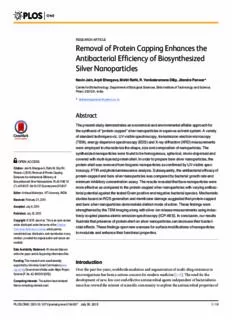
Removal of Protein Capping Enhances the Antibacterial Efficiency of Biosynthesized Silver PDF
Preview Removal of Protein Capping Enhances the Antibacterial Efficiency of Biosynthesized Silver
RESEARCHARTICLE Removal of Protein Capping Enhances the Antibacterial Efficiency of Biosynthesized Silver Nanoparticles NavinJain,ArpitBhargava,MohitRathi,R.VenkataramanaDilip,JitendraPanwar* CentreforBiotechnology,DepartmentofBiologicalSciences,BirlaInstituteofTechnologyandScience, Pilani,333031,India * [email protected] Abstract Thepresentstudydemonstratesaneconomicalandenvironmentalaffableapproachfor thesynthesisof“protein-capped”silvernanoparticlesinaqueoussolventsystem.Avariety ofstandardtechniquesviz.UV-visiblespectroscopy,transmissionelectronmicroscopy (TEM),energydispersivespectroscopy(EDS)andX-raydiffraction(XRD)measurements wereemployedtocharacterizetheshape,sizeandcompositionofnanoparticles.The synthesizednanoparticleswerefoundtobehomogenous,spherical,mono-dispersedand coveredwithmulti-layeredproteinshell.Inordertopreparebaresilvernanoparticles,the OPENACCESS proteinshellwasremovedfrombiogenicnanoparticlesasconfirmedbyUV-visiblespec- Citation:JainN,BhargavaA,RathiM,DilipRV, troscopy,FTIRandphotoluminescenceanalysis.Subsequently,theantibacterialefficacyof PanwarJ(2015)RemovalofProteinCapping EnhancestheAntibacterialEfficiencyof protein-cappedandbaresilvernanoparticleswascomparedbybacterialgrowthrateand BiosynthesizedSilverNanoparticles.PLoSONE10 minimuminhibitoryconcentrationassay.Theresultsrevealedthatbarenanoparticleswere (7):e0134337.doi:10.1371/journal.pone.0134337 moreeffectiveascomparedtotheprotein-cappedsilvernanoparticleswithvaryingantibac- Editor:AmitavaMukherjee,VITUniversity,INDIA terialpotentialagainstthetestedGrampositiveandnegativebacterialspecies.Mechanistic Received:February21,2015 studiesbasedonROSgenerationandmembranedamagesuggestedthatprotein-capped andbaresilvernanoparticlesdemonstratedistinctmodeofaction.Thesefindingswere Accepted:July8,2015 strengthenedbytheTEMimagingalongwithsilverionreleasemeasurementsusinginduc- Published:July30,2015 tivelycoupledplasmaatomicemissionspectroscopy(ICP-AES).Inconclusion,ourresults Copyright:©2015Jainetal.Thisisanopenaccess illustratethatpresenceofproteinshellonsilvernanoparticlescandecreasetheirbacteri- articledistributedunderthetermsoftheCreative cidaleffects.Thesefindingsopennewavenuesforsurfacemodificationsofnanoparticles CommonsAttributionLicense,whichpermits unrestricteduse,distribution,andreproductioninany tomodulateandenhancetheirfunctionalproperties. medium,providedtheoriginalauthorandsourceare credited. DataAvailabilityStatement:Allrelevantdataare withinthepaperanditsSupportingInformationfiles. Funding:Thisresearchworkwasfinancially Introduction supportedbyUniversityGrantCommission(www. ugc.ac.in),GovernmentofIndiaunderMajorProject Overthepastfewyears,worldwideescalationandaugmentationofmulti-drugresistancein Scheme[F.No.42-185/2013(SR)]. microorganismshasbeenaseriousconcernformodernmedicine[1–5].Theneedforthe developmentofnew,lowcostandeffectiveantimicrobialagentsindependentofbacterialresis- CompetingInterests:Theauthorshavedeclared thatnocompetinginterestsexist. tancehasrevivedtheinterestofscientificcommunitytoexploretheantimicrobialpropertiesof PLOSONE|DOI:10.1371/journal.pone.0134337 July30,2015 1/19 SurfaceModificationEnhancesAntibacterialActivityofAgNPs silveranditscompounds.Inpastfewyears,varietyofnewsilverformulationssuchassilver sulfadiazine,silvercitrate,silverlactate,etc.havebeendevelopedandvarioussilverintegrated formulations(Katadyn,Argyrol,Movidyn,Tetrasil,Alagon,etc.)werecommercialized[6]. However,costconcernandrecentreportsofsilver-resistantbacterialstrainshaslimitedthe useofsilverasapotentialalternativetoantibiotics[7]. Since,mostofthebiologicalprocessestakeplaceatthenanoscalelevel,acombinedapplica- tionofbiologyandnanotechnologycanperhapsmeetthischallenge[8].Utilizationofsilver nanoparticlescanbeparticularlyadvantageousascomparedtotheirbulkcounterpartasthe formermanifesthighsurfaceareatovolumeratiowhichcanprovidebettercontactwithmicro- organisms.Ithasbeendemonstratedthatsilvernanoparticlesrestrictthemicroorganismsto developresistance[9–11].Additionally,atlowconcentrationssilvernanoparticleshavebeen reportedtobenon-toxictohumancells,andhenceconsideredasansafeantimicrobialagent [12].Owingtotheseproperties,anenormousincreaseintheapplicationsofsilvernanoparti- clesforawiderangeofmedicalandcommercialproductshasbeenobservedwhichincludes householdantisepticspraysandantimicrobialcoatingsformedicaldevicesthatsterilzeairand surfaces[13].Silvernanoparticleshavealsoexpandedtheirhorizonsintextiles,cosmetics,air purifiers,foodpackaging,coatingforrefrigerators,waterdisinfection;infact,ineveryapplica- tionwherebacteriamayexertaharmfuleffect[14]. Themechanismofbactericidaleffectsofsilvernanoparticleshasnotbeenyetcompletely elucidated.Inparticular,thereisadebateastowhetherthetoxicityisonlyduetothesilver nanoparticlesoritisconfinedtothesilverionsreleasedfromthesenanoparticles.Ithasbeen reportedthatthereleaseofsilverionsfromthecrystallinecoreofsilvernanoparticlescontrib- utetothebactericidaleffects[15].Inaerobicconditions,silvernanoparticlesgetoxidised releasinghighconcentrationsofsilverionsinsolution,whichinteractswithproteinsgiving risetobactericidaleffects[16].Theantibacterialactivityofmicromolarconcentrationofsilver ionsmaybelinkedwithuncouplingofrespiratoryelectrontransportfromoxidativephosphor- ylation[17],inhibitionofrespiratorychainenzymesandinterferencewiththemembraneper- meability[18]orinteractionwithcytoplasmiccomponentsandnucleicacids[19].However, themolecularmechanismbehindthebactericidalactivityofsilverionsisstillnotclear.Inaddi- tion,whetherthebactericidaleffectsareexertedbynanoscalephnemenonisanelusiveques- tion.Xiuetal.[20]attemptedtodecipherthischallengebyperformingantibacterialstudies understrictanaerobicconditionstoprecludesilveroxidationandAg+release.Theirfindings completelyruledoutthedirectparticle-specificbactericidaleffectsofsilvernanoparticlesand inferredAg+ionsasthedefinitivemoleculartoxicantforbactericidaleffects.Thus,astrictcon- troloverthereleaseofsilverionsisapre-requisitefortheantibacterialefficacyofsilvernano- particles.Manipulationatvariouslevelssuchasparticlesize,morphology,surfacecharge, coatingandoxygenavailablityhavebeenconsideredasimportantparameterstocontroland modulatetheantibacterialactivityofsilvernanoparticles.Amongtheseparameters,surface coating(orfunctionalization)serveasthemostimportantfactorwhichdeterminethenano- particle-microbeinteractions.Ithasbeenobservedthatcoatingofsilvernanoparticleswith surfactantsresultsingreaterdamagetomicroorganismsincomparisontosimilar-sizedbare silvernanoparticles[21,22].Similarly,comparitivestudiesofpolysaccharidecoatedandbare silvernanoparticlesshowedthatpresenceofpolysaccharidemoleculesonnanoparticlesurface facilitatesthedamagetomammaliancell-lines[23].Conversely,nanoparticleswerefoundto belesstoxictomicroorganismswhencoatedwithpolymersornaturalorganicmatter[24]. Variegatedeffectsofsurfacechemistryonsilvernanoparticleuptakeandtoxicityhavealso beenreported.Forinstance,presenceofmoleculessuchasalbumin,lecithin,polysorbital-80 andpeptideonthenanoparticlesurfacehavebeenreportedtofacilitatetheiruptakeandtoxic- ity,whilepolyethyleneglycolinterferedwithuptakeinthelivercells[25].Incontrast,a PLOSONE|DOI:10.1371/journal.pone.0134337 July30,2015 2/19 SurfaceModificationEnhancesAntibacterialActivityofAgNPs systematicsub-chronicreproductiontoxicityassessmentofsilvernanoparticlescoatedwith polyvinylpyrrolidone(hydrophilic)oroleicacid(amphiphilic)onsoilearthworms(Eisenia fetida)showednosignificantdifferencesinsilveraccumulationortoxicity[26].Hence,studies targetedtounderstandthedynamicbehaviourofnanoparticlecoatings(inorganicororganic) couldbehighlyinformativefordesigningefficientantibacterialformulationsofsilver nanoparticles. Inthepresentstudy,wearereportingaone-stepprotocoltosynthesize“protein-capped” silvernanoparticlesusingAspergillussp.NJP02.Thepresenceofproteinshellonnanoparticles ishighlyadvantageousasitimpartssolubilityandcolloidalstabilityinaqueoussystem.In ordertofindouttheroleofproteinshellinmodulatingantibacterialefficacy,thecomparative antibacterialpotentialofprotein-cappedandbaresilvernanoparticleswereassessed.Our resultsclearlyindicatethatthepresenceofproteinshelloverthesurfaceofsilvernanoparticles negativelyaffecttheirantibacterialpotential.Furthermechanisticstudiessuggestedthatpro- tein-cappedandbaresilvernanoparticlesdemonstratedistinctmodeofaction. Experimental FungusAspergillussp.NJP02(GenBankaccessionnumber:HM222932)wasusedfortheextra- cellularsynthesisofsilvernanoparticles.Thecompletedetailsforisolationandmolecularchar- acterizationoftheisolatecanbeobtainedfromourpreviousreport[27]. Synthesisandcharacterizationofprotein-cappedandbaresilver nanoparticles Theextracellularsynthesisofsilvernanoparticleswasachievedusinganindigenousprotocol developedinourlaboratory[28].Briefly,thefunguswasgrowninMGYPmediumfor72hat 28°Conarotaryshaker(150rpm)underdarkconditions.Afterincubation,thefungalmycelia wereseparatedandwashedthricewithsterilewaterinordertoremovealltracesofmedia.Typ- ically,10gofbiomass(freshweight)wasresuspendedin100mLofsteriledeionizedMilli-Q waterandfurtherincubatedfor72hunderthesameconditionsasdescribedabove.Afterincu- bation,biomasswasseparatedbyfiltrationusingWhatmanfilterpaperno.1andthefungal cellfreefiltratecontainingextracellularsecretionswascollected.Forsynthesisofsilvernano- particles,aqueoussilvernitratesolutionatafinalconcentrationof1.0mMwasaddedtothe reactionvesselscontainingcell-freefiltrateandincubatedat28°Conarotaryshaker(150rpm) withoutlight.Theobtainedprotein-cappedsilvernanoparticleswereusedforfurtherexperi- ments.TheparticleswerecharacterizedbyUV-visiblespectroscopy,dynamiclightscattering (DLS),transmissionelectronmicroscopy(TEM),energydispersivespectroscopy(EDS)and selectedareaelectrondiffraction(SAED)analysis.Thedetailedproceduresfortheaboveanaly- seshavebeendiscussedinourpreviousreport[28].Thecrystallinephaseofnanoparticleswas measuredbyX-raydiffraction(XRD)studiesusingaRigakuMiniFlex-IIbenchtopdiffractom- eteroperatedatavoltageof40kVandcurrentof30mAwithCuKαradiation.Inorderto checkthestabilityofprotein-cappedsilvernanoparticles,UV-visiblespectrumofthreemonth oldsamplewasalsorecorded. Forpreparationofbaresilvernanoparticles,theas-synthesizedprotein-cappedsilvernano- particlesolutionwascentrifugedat10,000rpmfor20min.Thepelletwassuspendedin1% (w/v)sodiumdodecylsulphate(SDS)andboiledinwaterbathfor30mininordertodetach theproteinshellfromnanoparticlesfollowedbycentrifugationat10,000rpmfor20min.The supernatantcontainingtheunreactedSDSandSDS-proteincomplexwasanalyzedforthe presenceofproteinsbymeasuringtheUV-visibleabsorptionspectrum.Theresultingpellet wasboiledin1mLofTris-Cl(pH8.0)inwaterbathfor10mintoeliminatethepossibilityof PLOSONE|DOI:10.1371/journal.pone.0134337 July30,2015 3/19 SurfaceModificationEnhancesAntibacterialActivityofAgNPs SDSbindingtothenanoparticles,ifany.ToensurethecompleteremovalofSDS,dialysiswas carriedoutagainstMilli-Qwaterwithfourchangesofwater.Theobtainedbaresilvernanopar- ticleswerecharacterizedusingFouriertransforminfraredspectroscopy(FTIR),Photolumines- cence(PL)spectroscopy,UV-visiblespectroscopyandDLSmeasurements.FTIRspectraof freeze-driedsampleswererecordedonaShimazduIRPrestige-21FTIRspectrometer.Photolu- minescencemeasurementswereperformedonaHoribaFluroMax-4spectrofluorometerwith anexcitationwavelengthof280nmusing90°illumination.Inordertoachievemaximal signal-to-noiseratio,excitationandemissionslitwidthvalueswereattunedto2.5and3.0nm, respectively.UV-visiblespectroscopymeasurementswerecarriedoutonaJascoV-630UV- visiblespectrophotometerataresolutionof1nm.DLSmeasurementswereconductedusinga MalvernZetasizerNanoZSinstrumentandtheobtaineddatawereanalysedusingZetasizer software. Antibacterialefficiencyofsilvernanoparticles Invitrobactericidaleffectsofprotein-cappedandbaresilvernanoparticleswereevaluated againstclinically-importantbacterialpathogensprocuredfromtheInstituteofMicrobialTech- nology,India.ThetestedstrainswereGrampositiveBacilluscereus(MTCC430)andPseudo- monasputida(MTCC102);andGramnegativeEscherichiacoli(MTCC1652)andKlebsiella pneumoniae(MTCC432).Theselectedbacterialspecieswereexposedtoprotein-cappedor baresilvernanoparticles(50μgnanoparticlespermLofmedium)for30minat37°Cunless otherwisestated. Assaysforantibacterialactivity. Toexaminetheeffectonbacterialgrowthrate,the selectedbacterialspeciesweregrownseparatelyin100mLofnutrientbrothsupplemented with50μgofprotein-cappedorbaresilvernanoparticlespermLofmedium.Thebacterial growthratesweredeterminedbymeasuringtheabsorbanceat600nmatdifferenttimeinter- vals(0.1absorbancecorrespondstoaconcentrationof108cellspermL).Mediawithoutnano- particlesandbacterialcellswereusedaspositiveandnegativecontrols,respectively. Minimuminhibitoryconcentration(MIC)valuesofprotein-cappedandbaresilvernano- particlesweredeterminedbyperformingdehydrogenaseassayina96-wellplate.Bacterial inoculumswerepreparedbywashingtheovernightgrownculturetwicewithphosphatebuffer saline(pH7.4)followedbydilutiontoachieveafinalconcentrationof108cfumL-1.100μLof bacterialinoculumand20μLoftriphenyltetrazoliumchloride(TTC;3mgmL-1solution) wereaddedineachwell.Subsequently,20μLof50μgmL-1silvernanoparticle(protein-capped orbare)solutionwasaddedandtheplateswereincubatedfor18hoursat37°Cunderdarkcon- ditions.Thetriphenylformazan(TPF)formedwasmeasuredat485nmusinganELISAreader. TheMICassaywasdoneintriplicateandexecutedthricetovalidatetheMICvaluesforthe eachtestedbacterialspecies. Assaysforantibacterialmechanism. Thegenerationofintracellularreactiveoxygenspe- cies(ROS)inpresenceofprotein-cappedorbaresilvernanoparticleswasdeterminedusingan oxidation-sensitivefluorescentdye2,7-dichlorodihydrofluoresceindiacetate(DCFH-DA)in triplicateasperthestandardprotocol[29].Briefly,theovernightgrownbacterialcells(108cfu mL-1)werewashedthricewithphosphate-bufferedsaline(pH7.4)andfurthersuspendedin freshnutrientbroth.DCFH-DA(10μMinphosphate-bufferedsaline)wasmixedinthe mediumataratioof1:2,000(dye:medium)andincubatedfor30minat37°Cindarkcondi- tionstosuccessfullypenetratethedyeintothebacterialcells.TheDCFH-DAloadedcellswere separatedfromthefreedyemoleculesbycentrifugationat8,000rpmfor5minfollowedbya finalwashwiththephosphate-bufferedsaline(pH7.4).Thebacterialpelletswereexposedto protein-cappedorbaresilvernanoparticlesasmentionedearlier.Inlivingbacterialcells, PLOSONE|DOI:10.1371/journal.pone.0134337 July30,2015 4/19 SurfaceModificationEnhancesAntibacterialActivityofAgNPs intracellularesterasesresultinhydrolysisofDCFH-DAtonon-fluorescent2,7-dichlorodihy- drofluorescin(DCFH)whichinpresenceofROSoxidizestofluorescentdichlorodihydrofluor- escin(DCF)[30].ThefluorescentsignalintensityofDCFwasmeasuredbyPerkinElmer VICTORXMultilabelPlateReaderatanexcitationandemissionwavelengthof485nmand 535nm,respectively.Bacterialcellsincubatedin25mMascorbicacidfor1hbeforeDCFH-DA exposurewereusedaspositivecontrolwhilecellswithoutDCFH-DAtreatmentwereusedas negativecontrol[31]. Peroxidaseandsuperoxidedismutase(SOD)activitiesweremeasuredintriplicatefollowing themethodofHochmanandGoldberg[32]andAroraetal.[33],respectively.Afterexposure, thebacterialcellswerecentrifugedat8,000rpmfor5minandthepelletwassonicatedto obtainthecrudeenzymeextract.Bacterialculturewithoutnanoparticletreatmentservedas control. Reactionmixturefortheassayofperoxidasecontained1mLof0.01Mpyrogallol,2mLof 0.1Mphosphatebuffer(pH6.0),and1mLof5mMhydrogenperoxide[32].Thereactionwas initiatedbyadding1mLofenzymeextractandthemixturewasincubatedat25°Cfor5min. Subsequently,thereactionwasterminatedbyadding1mLof2.5NH SO andtheamountof 2 4 purpurogallinformedwasestimatedbymeasuringtheabsorbanceat420nm.Inblank,1mL ofsterilewaterwasusedinsteadofextract.Oneunitofperoxidasewasdefinedastheamount ofenzymerequiredtoform1mgofpurpurogallinperminunderthespecifiedconditions. TheSODassayisbasedontheabilityofSODtoinhibitthephotochemicalreductionof nitrobluetetrazolium(NBT)[33].ReactionmixturefortheassayofSODcontained13.0mM methionine,6.3μMNBT,6.5μMriboflavin,0.1mMEDTA,and50mMphosphatebuffer(pH 7.8).Thereactionwasinitiatedbyadding500μlenzymeextract(diluted10times)to1.5mLof reactionmixturefollowedbyincubationat30°Cfor10minunder6000luxlightintensity. Afterincubation,thetubeswereimmediatelytransferredtodarkconditionsandtheabsor- bancewasmeasuredat560nm.Reactionmixturecontainingsterilewaterinsteadofenzyme extractservedasblank.Thenon-irradiatedreactionmixtureservedasnegativecontrol.One unitoftheSODactivitywasdefinedastheamountofenzymerequiredtoinhibitthereduction ofNBTby50%underthespecifiedconditions. Malondialdehyde(MDA)formation,ameasureofmembranedamagewasmonitoredusing thiobarbituricacid(TBA)asaprobemolecule[34].Afterexposuretoprotein-cappedorbare silvernanoparticles,thebacterialcellswerehydratedin1mLof2.5%(w/v)trichloroaceticacid (TCA)andsubsequentlycentrifugedat12,000rpmfor20minat4°C.Thesupernatant(100μl) wasmixedwith0.5%(w/v)TBAreagentpreparedin20%(w/v)TCA.Thereactionmixture washeatedat100°Cfor30mininawaterbathfollowedbycentrifugationat12,000rpmfor 10minat4°C.TheabsorbanceoftheMDA-TBAadductwasmeasuredat532nm.MDAcon- tentwasexpressedaspicomolespermgofproteinusingamolarextinctioncoefficientof1.56 mM-1cm-1[34].Theextentofmembraneleakagewasalsodeterminedbyquantificationof protein[35],totalsugar[36]andnucleicacidcontent.Thenucleicacidleakagewasdetectedby measuringtheabsorbanceofculturesupernatantat260nm(1ODunit=50μgmL-1nucleic acid). Inductivelycoupledplasmaatomicemissionspectroscopy(ICP-AES)measurements. Thedissolutionofsilverionsfromprotein-cappedorbaresilvernanoparticleswasmeasured innutrientmediumafterexposuretobacterialcells.Thesilverionswereseparatedbydialyzing theculturemediumagainststerileMilli-Qwaterfor12husinga12kDacellulosemembrane andmeasuredbyShimadzuICPS-7500instrument.Thesilverionconcentrationinnutrient medium(withoutsilvernanoparticles)wasusedascontrol. TEMimaging. InordertopreparesampleforTEMimaging,nanoparticletreatedbacterial cellswerecentrifugedat5,000rpmfor2min.Thebacterialpelletswerewashedtwicewith PLOSONE|DOI:10.1371/journal.pone.0134337 July30,2015 5/19 SurfaceModificationEnhancesAntibacterialActivityofAgNPs Fig1.UVvisiblespectrumofreactionmediumasafunctionoftime(0,12,24,48and72h).Insetshows tubescontainingfungalcell-freefiltrate(a)withoutand(b)withsilvernitratesolutionafter72hofreaction. doi:10.1371/journal.pone.0134337.g001 phosphatebuffersaline(pH7.2)followedbyapre-fixationstepwith2.5%glutaraldehyde(pre- paredin0.1Mcacodylatebuffer)for2hat4°C.Post-fixationofthebacterialcellswasper- formedwith1%OsO treatmentfor1hat4°C.Afterpost-fixation,theOsO solutionwas 4 4 removedbywashingtwicethebacterialcellswith0.1Mcacodylatebufferfollowedbystaining withfiltereduranylacetate(1%)solution.ForTEMimaging,adropofstainedbacterialsample wasplacedonacarbon-coatedcoppergridanddriedovernightinavacuumdesiccator.Thegrids wereobservedonaHitachiH-7650TEMinstrumentoperatedataconstantvoltageof100kV. ResultsandDiscussion Characterizationofprotein-cappedandbaresilvernanoparticles Agradualchangeinthecolourofreactionmedium(containingfungalcell-freefiltrateand precursorsilverions)fromcolourlesstoreddishbrownrevealedavisualevidenceforsilver nanoparticlesynthesis(Fig1inset).UV-visiblespectrumshowedagradualincreaseinthe absorbanceat429nmwithrespecttotime(Fig1).Theabsorptionmaximaat429nmcanbe attributedtothesurfaceplasmonresonance(SPR)vibrationsofsynthesizedsilvernanoparti- cles[37].Nofurtherincreaseinabsorbancewasobservedafter72hofreaction(datanot shown),whichindicatedthecompletereductionofprecursorsilverionsinreactionmedium. Stabilityofas-synthesizedsilvernanoparticleswasmonitoredperiodicallyformorethanthree months.Itwasobservedthatthenanoparticlesolutionwasextremelystableatroomtempera- ture,withnoevidenceofparticleaggregationasdeterminedbyUV-visiblespectroscopy measurements. TEMmicrograph(Fig2A)revealedthepresenceofmono-dispersedandpredominantly sphericalparticleswithnovisibleaggregation.TheSAEDpattern(Fig2Ainset)atteststhe crystallanityofsilvernanoparticles.Theparticlesizedistributionhistogramobtainedfrom TEMmeasurementsrevealedthatmostoftheparticlesrangedbetween40–80nmwithamean diameterof54±8.9nm(Fig2B).Theseresultswereinwellagreementwiththevaluesobtained byDLSmeasurements(Fig2C).Ithasbeenwellreportedthatdifferentfungicansynthesize nanoparticlesofvariedcomposition,sizesandshapeswhichmaybeduetothedifferencesin theirextracellularproteinprofiles[38–40]. PLOSONE|DOI:10.1371/journal.pone.0134337 July30,2015 6/19 SurfaceModificationEnhancesAntibacterialActivityofAgNPs PLOSONE|DOI:10.1371/journal.pone.0134337 July30,2015 7/19 SurfaceModificationEnhancesAntibacterialActivityofAgNPs Fig2.(A)Arepresentativetransmissionelectronmicrographshowingsphericalshapedsilver nanoparticles(scalebarequivalentto50nm).InsetshowingSAEDpatternrecordedfromasingle nanoparticle.Particlesizedistributionhistogramofsilvernanoparticlesasdeterminedusing(B) transmissionelectronmicroscopeand(C)dynamiclightscatteringmeasurements. doi:10.1371/journal.pone.0134337.g002 X-raydiffractionpatternrecordedbypreparingdrop-coatedfilmofprotein-cappedsilver nanoparticlesfurthervalidatedthecrystallinenatureofnanoparticles.Thewell-definedpeaks at2θvaluesof38.03°,46.18°,64.60°,and77.18°correspondsto(111),(200),(220)and(311) planesofsilver,respectively(Fig3A).Thesevalueswereincompleteagreementwiththeface- centeredcubic(fcc)latticestructureofcrystallinesilver(JCPDSfileno.04–0783).Asimilar patternofXRDspectrumhasbeenreportedformetallicsilvernanoparticlessynthesizedby otherfungi[41].EDSwascarriedouttodeterminetheelementalcompositionofas-synthe- sizednanoparticlesandcappingmolecules.Anintenseopticalabsorptionbandat3.0KeV Fig3.(A)XRDspectrumofas-synthesizedprotein-cappedsilvernanoparticleswithBragg’s diffractionvaluesshowninparentheses.(B)EDSspectrumshowingtheelementalcompositionof silvernanoparticles. doi:10.1371/journal.pone.0134337.g003 PLOSONE|DOI:10.1371/journal.pone.0134337 July30,2015 8/19 SurfaceModificationEnhancesAntibacterialActivityofAgNPs Fig4.(A)FTIRspectraand(B)Photoluminescencespectraofprotein-cappedandbaresilver nanoparticles. doi:10.1371/journal.pone.0134337.g004 confirmedthepresenceofpuremetallicsilvernanoparticles(Fig3B).Otherpeaksobservedfor C,NandOatomsindicatedthepresenceofproteinsascappingmolecules. UV-visibleabsorptionspectrumofsupernatantobtainedafterSDStreatmentofassynthe- sizedsilvernanoparticlesshowedabroadabsorptionpeaknear280nmwhichcorrespondsto aromaticaminoacidsofproteinsS1Fig[28].FTIRandphotoluminescencemeasurementsof protein-cappedandbaresilvernanoparticleswerecarriedouttoconfirmtheremovalofcap- pingproteinsfromthesurfaceofsilvernanoparticles.FTIRspectrumofprotein-cappedsilver nanoparticles(Fig4A)exhibitedcharacteristicbandsofamideIandamideIIatwavenumbers 1651and1539cm-1,respectivelyandC-Nstretchingvibrationbandofaliphaticamineat1029 cm-1[28].ThedisappearanceofthesecharacteristicproteinbandsintheFTIRspectrumof baresilvernanoparticlesclearlyindicatedtheremovalofproteinsfromnanoparticles.ThePL spectrum(Fig4B)ofprotein-cappedsilvernanoparticlesshowedadistinctemissionpeakat 340nm,whichcouldbeattributedtothetyrosineresiduesofcappingproteins.Incontrast, PLOSONE|DOI:10.1371/journal.pone.0134337 July30,2015 9/19 SurfaceModificationEnhancesAntibacterialActivityofAgNPs Fig5.(A)UVvisiblespectraand(B)particlesizedistributionofprotein-cappedandbaresilver nanoparticles. doi:10.1371/journal.pone.0134337.g005 absenceofemissionpeakincaseofbaresilvernanoparticlesconfirmedthecompleteremoval ofproteinmolecules. TheremovalofproteinshellbySDStreatmentreducedthesizeofnanoparticlesasreflected bytheblueshiftobservedintheSPRpeakfrom429to425nmincaseofbaresilvernanoparti- cle(Fig5A).Calzolaietal.[42]reportedasimilarobservationwhilestudyinginteraction betweenhumanubiquitinandgoldnanoparticles.Furthermore,hydrodynamicparticlesize distributionandpolydispersityindex(PDI)analysiswascarriedouttoinvestigatetheoccu- pancyofproteinshellincaseofprotein-cappedsilvernanoparticles.Theprotein-cappedsilver nanoparticlesshowedameanparticlesizeof90.53nm(PDI=0.357)whichdecreasedto58.39 nm(PDI=0.396)incaseofbaresilvernanoparticlesindicatingthesuccessfulremovalofpro- teinshellfromnanoparticlesafterSDStreatment(Fig5B).Theplausiblereasonformulti-lay- eredshell(~32nmthick)couldbethenon-specificandnon-competitivebindingofproteins presentinthesurroundingenvironment(reactionmedium).Thepersistenceofthickprotein shellonbiogenicsilvernanoparticleshasattractedourattentiontocomparetheantibacterial efficacyofprotein-cappednanoparticlesincomparisontobaresilvernanoparticles. Antibacterialefficacyofprotein-cappedandbaresilvernanoparticles Thetime-dependentbacterialgrowthinpresenceofprotein-cappedandbaresilvernanoparti- cleswasmonitoredbymeasuringtheabsorbanceat600nm[43].Theprotein-cappedaswellas PLOSONE|DOI:10.1371/journal.pone.0134337 July30,2015 10/19
Description: